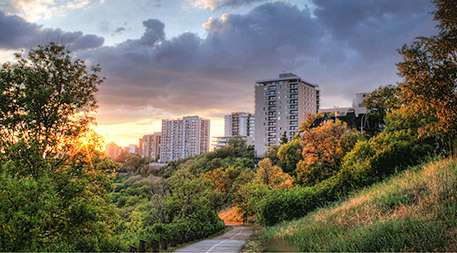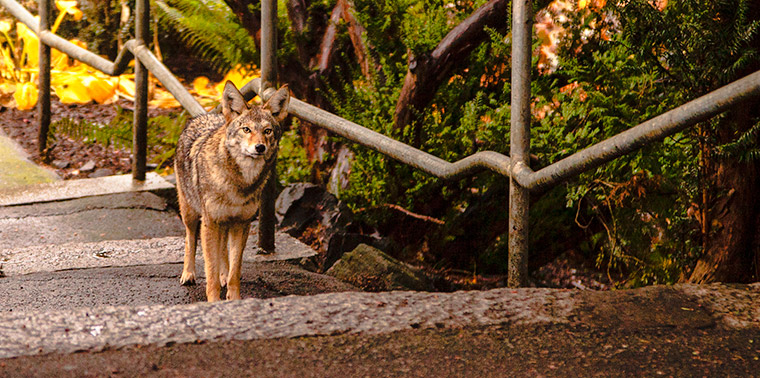October 19, 2016 — The North Saskatchewan River winds through the center of Edmonton, its waters and the surrounding landscape forming a green spine that spreads a network of ravines out into nearby neighborhoods. Since 1904, when the Canadian city was incorporated, it has prioritized this river ecosystem. But the city is growing — from 600,000 people in 1990 to nearly 900,000 today — and that’s pushing development and transportation infrastructure up against this riverine system. Habitats are being reduced in size and fragmented by roads, creating many risks for the river valley’s wildlife.
Recognizing the threat urban development posed for the river ecosystem, Edmonton embarked on an ambitious effort to accommodate growth while at the same time protecting wildlife and habitat. In 2007, the city built its first wildlife passage — a culvert that allows small mammals to pass between two sections of ravine that had been cut up by a road. More were soon planned. Led by the city’s planning department, the city has now built 27 wildlife passages, reconnecting habitat and enabling the safe movement of animals of all sizes — everything from birds to amphibians to mammals such as weasels, porcupines and moose.
But Grant Pearsell, director of Parks and Biodiversity for the Department of City Planning, says the city isn’t simply designing wildlife passages. “It’s more that we’re accommodating wildlife in the design of our infrastructure,” he says. “There’s a difference.”

The city of Edmonton in Alberta, Canada, prioritizes wildlife and habitat alongside development. Photo by WinterE229 (Wikipedia/Creative Commons)
Bringing nature back into cities — or preventing it from being destroyed — is a growing imperative in cities across the world. Taking lessons from conservation biology and applying them to the built environment, cities are proactively creating habitat for certain animals, increasing urban tree canopies and even reintroducing species that have long been displaced by roads and buildings.
“You’re taking something that is completely artificial and manmade and making it something wild,” says Rebecca Senior, a graduate student at the University of Sheffield who’s been working with Rewilding Britain, a group focused on re-creating habitat and reintroducing species such as boar, lynx and bluefin tuna across the U.K.
It’s a concept known as urban rewilding, and while it can be good for plants and animals, it’s also good for people. “There’s all this evidence about the biophysical ways that nature affects us and has positive effects on our mood, reduces our stress hormone levels and boosts our immune system,” says Timothy Beatley, a planning professor at the University of Virginia who leads the Biophilic Cities Project, a network of communities that seeks to create a better connection between people and nature through urban design. “It can’t just be something that you get on the weekend or during the holiday months. It has to be all around us. It has to be integrated into our daily lives and into the neighborhoods we live in and the office and work environments we spend our time in.”
Vetting Species
Though many efforts to reintroduce species tend to happen in more rural or natural settings, such as the reintroduction of wolves to Yellowstone National Park, conservationists are finding new opportunities to integrate habitats and wildlife into urban environments.
Where rewilding can take place, though, depends on what species a city is trying to encourage, according to Luis Mata, a research fellow at RMIT University in Melbourne, Australia, who is studying how to reintroduce species into urban settings — which plant and animal species should be reintroduced and where to develop habitat to allow them to thrive. The decisions can be complicated. Species have to be vetted for their suitability to sometimes harsh urban settings, their ability to perform ecosystem services such as stormwater cleansing or pollination, their potential positive or negative impacts on people, and, somewhat superficially, their charisma.
Mata is hoping to establish a network of potential rewilding sites throughout Melbourne that can be used to test the habitat requirements of species that make it through that multi-step decision tree. The goal is to use these sites as a way to kick-start the repopulation of native species like the blue banded bee.
“Some species will be able to naturally disperse if we provide habitat,” Mata says. “Even if you don’t consciously target a species for rewilding, by providing habitat you could get these communities dispersing to different parts of the city and rewilding parts of the city where the species has been locally extinct or gone for a while just because it doesn’t have the right habitat to connect back to its broader metacommunity.”
From Big to Small
Rewilding efforts are happening at a wide variety of scales, from Edmonton’s citywide network of wildlife passages to small butterfly gardens planted in cities like St. Louis, San Francisco and Toronto. Singapore is often highlighted as a leader in urban rewilding for its efforts to integrate green roofs and walls into its buildings, offset the removal of greenspace for development projects, and convert a formerly paved section of the Kallang River into a 153-acre (62-hectare) park.

An “urban ecosanctuary” near Wellington, New Zealand, known as Zealandia has led to the reintroduction of 18 species, six of which had been extinct on mainland New Zealand. Photo by Howard/Harriet Greenwood (Flickr/Creative Commons)
Some rewilding efforts are even more elaborate. In perhaps one of the most advanced urban rewilding projects in the world, a private group of ecologists in the city of Wellington, New Zealand, have developed Zealandia, a 555-acre (225-hectare) “urban ecosanctuary” about a mile from downtown. The project aims to return this part of the city as closely as possible to its prehuman state. A big part of that revolves around eliminating the mammals and predators introduced to New Zealand by its European colonizers. Before settlement, New Zealand had no native terrestrial mammals (save for a few bat species) and an incredibly diverse population of bird species. The introduction of mammals like ferrets, possums and house cats devastated many bird populations, even causing some to go regionally extinct.
A special predator-proof fence has been built around the Zealandia site, allowing bird, reptile and amphibian populations to thrive. The project has reintroduced 18 species to the site; six of those had been extinct for more than 100 years from mainland New Zealand. “It’s getting so good in there that they’re actually starting to flow out into the city and surrounds,” says Danielle Shanahan, Zealandia’s manager of conservation, research, learning and experience. “People are seeing some of these endangered species in their backyard.”
The project is about conservation at its core, but it’s also about reconnecting people with nature.
“We talk a lot about extinction of experience, how people are having a reduced experience of nature than people had in the past, but with this kind of a project, you’re actually seeing the reverse happening,” Shanahan says. “Kids are actually seeing more species in the wild than we ever did, which is kind of cool.”
Scientists and city officials alike are hoping this increased connection with nature will create long-term benefits, both for cities and for people. But even if they don’t, it’s hard to argue against adding greenspace to the city.
“On protecting nature, if it doesn’t work out I always say you can always make it a strip mall later,” says Edmonton’s Pearsell. “Nobody’s ever said we made a big mistake in protecting a bit of nature.” ![]()
Ensia shares solutions-focused stories free of charge through our online magazine and partner media. That means audiences around the world have ready access to stories that can — and do — help them shape a better future. If you value our work, please show your support today.
Yes, I'll support Ensia!

If you liked this... you might find this of interest:
Alladale – a rewilding adventure
Alladale Wilderness Reserve enables us to experience a rewilding project in action
http://www.ecohustler.co.uk/2015/08/24/alladale-a-rewilding-adventure/